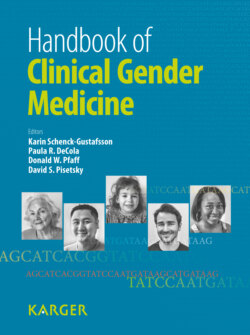Читать книгу Handbook of Clinical Gender Medicine - Группа авторов - Страница 68
На сайте Литреса книга снята с продажи.
Genetic Causes
ОглавлениеFamily cases of hypospadias are well reported, with percentages varying between 10 and 25%. The risk of having another boy with hypospadias in a family with one case is increased 17-fold compared to controls [9]. Many genes have been reported in association with abnormal genital construction: those involved in GT development (HOX, FGF, ATF3, CXorf6, etc.), those involved in gonadal determination and testicular development (WT1, SF1, SOX9, DMRT1, DAX1, WNT4, etc.), those involved in androgen synthesis located in Leydig cells, and those involved in androgen action on target tissues (5-α reductase) [8].
Chromosomal anomalies are found in 7% of patients with isolated hypospadias, more frequently if other genital anomalies are associated. Several well-identified syndromes may associate an abnormal GT: Klinefelter syndrome (47,XXY), mixed gonadal dysgenesis (45, X0/46, XY), 46, XX males with or without a detectable SRY gene, and ovotesticular DSD (46, XX in 60% cases and 46, XY/46, XX in 40%) [10, 11].
